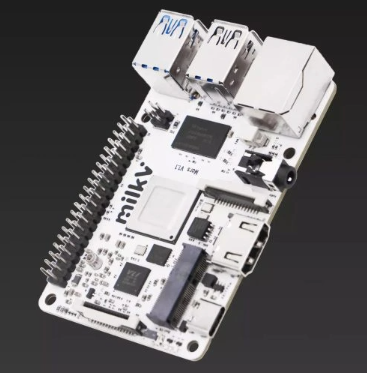 Technology peripherals
Technology peripherals
 It Industry
It Industry
 Innovative design: Milk-V Mars has different processor options than traditional Raspberry Pi
Innovative design: Milk-V Mars has different processor options than traditional Raspberry Pi
Innovative design: Milk-V Mars has different processor options than traditional Raspberry Pi
News on June 6, Milk-V Mars is an eye-catching microcomputer that uses the new RISC-V architecture 1.5GHz StarFive The JH7110 quad-core processor is different from traditional processors based on ARM architecture. This credit card-sized single-board computer looks similar to the popular Raspberry Pi Pi), but has some innovations in processor selection.
Milk-V Mars measures 85mm x 56mm (3.3 inches x 2.2 inches), the memory capacity can be expanded from 1GB to 8GB of LPDDR4 memory. In addition, it is equipped with an eMMC slot for flash storage and a microSD slot for mobile storage, providing users with greater storage space options.

According to the editor’s understanding, Milk-V Mars has a rich set of interfaces and connectors. It includes an HDMI interface and two MIPI-DSI interfaces (2-channel and 4-channel), allowing users to connect up to two displays. In addition, it also provides a Gigabit Ethernet interface, three USB 3.0 Type-A interface, a USB 2.0 Type-A interface and a USB-C interface (for 5V/3A power input). It also comes with an M.2 E-Key interface can be used to install WiFi and Bluetooth modules. At the same time, Milk-V Mars also provides a 40-pin GPIO general-purpose input and output interface provides users with more expansion and connection options.
Milk-V Mars can not only be used as a fanless PC, but also supports the connection of external fans. In addition to using the USB-C interface for power supply, the GPIO connector can also be used as a power input interface and also supports Power over Ethernet function. This makes Milk-V Mars has greater adaptability and flexibility and can meet the needs of different users.
Milk-V The powerful performance of Mars is impressive. It supports H.264 and H.265 video playback up to 4K/60fps, and can encode H.265 video up to 1080p/30fps. Whether at work or for entertainment, users can enjoy a smooth and high-quality video experience.
The above is the detailed content of Innovative design: Milk-V Mars has different processor options than traditional Raspberry Pi. For more information, please follow other related articles on the PHP Chinese website!

Hot AI Tools

Undresser.AI Undress
AI-powered app for creating realistic nude photos

AI Clothes Remover
Online AI tool for removing clothes from photos.

Undress AI Tool
Undress images for free

Clothoff.io
AI clothes remover

Video Face Swap
Swap faces in any video effortlessly with our completely free AI face swap tool!

Hot Article

Hot Tools

Notepad++7.3.1
Easy-to-use and free code editor

SublimeText3 Chinese version
Chinese version, very easy to use

Zend Studio 13.0.1
Powerful PHP integrated development environment

Dreamweaver CS6
Visual web development tools

SublimeText3 Mac version
God-level code editing software (SublimeText3)

Hot Topics
 1389
1389
 52
52
 Building a Network Vulnerability Scanner with Go
Apr 01, 2025 am 08:27 AM
Building a Network Vulnerability Scanner with Go
Apr 01, 2025 am 08:27 AM
This Go-based network vulnerability scanner efficiently identifies potential security weaknesses. It leverages Go's concurrency features for speed and includes service detection and vulnerability matching. Let's explore its capabilities and ethical
 CNCF Arm64 Pilot: Impact and Insights
Apr 15, 2025 am 08:27 AM
CNCF Arm64 Pilot: Impact and Insights
Apr 15, 2025 am 08:27 AM
This pilot program, a collaboration between the CNCF (Cloud Native Computing Foundation), Ampere Computing, Equinix Metal, and Actuated, streamlines arm64 CI/CD for CNCF GitHub projects. The initiative addresses security concerns and performance lim
 Serverless Image Processing Pipeline with AWS ECS and Lambda
Apr 18, 2025 am 08:28 AM
Serverless Image Processing Pipeline with AWS ECS and Lambda
Apr 18, 2025 am 08:28 AM
This tutorial guides you through building a serverless image processing pipeline using AWS services. We'll create a Next.js frontend deployed on an ECS Fargate cluster, interacting with an API Gateway, Lambda functions, S3 buckets, and DynamoDB. Th



